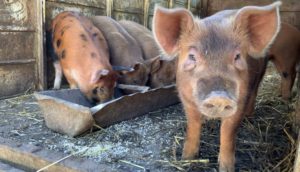Summary:
Pigs are raised on farms primarily to provide meat. They have been bred to grow quickly and have large litters (a litter is a group of young born at the same time). They are unique farm animals because they are both scavengers and omnivores and use their upturned snouts to search for food, unearthing worms, bugs and roots.
Know-It-All
- What adaptations do pigs have to help them survive?
- Why should you hide your fingers when visiting the pigs?
- Pigs are omnivores and scavengers, what does that mean?
- Animals fit into three categories depending on what they eat. What is the scientific word for an animal that eats only plants? What is the scientific word for an animal that eats only meat? What is the scientific word for an animal that eats both plants and meat?
- What type of teeth do each of these animals need to eat the type of food they do?
- What types of meat products do some people get from pigs? What other products do people get from pigs?
Digging Deeper
People often confuse the term Herbivore with Vegetarian. Herbivores can only digest plant matter and do not have the teeth needed to cut through meat. A vegetarian is a person who chooses not to eat meat.
Humans are Omnivores because we have cutting teeth in the front and flat, grinding teeth in the back. Our teeth are built to allow us to eat both plants and animals. The amazing thing about humans is that we have developed so many different preferences for different kinds of plant and animal foods.
Here are some examples of dietary, or food, preferences that many people choose: Some humans are vegetarians, some pescatarians, and others vegan (to name a few). While vegetarians do not eat meat, they may eat or drink dairy products. Pescatarians eat fish, but not other meat products. Vegans do not eat or use any animal products at all. Imagine how challenging it can be to avoid all animal products, including eggs, leather, gelatin products (like jello), and ICE CREAM!
Try It
A) One adaptation Nicole talked about was pigs’ ability to use their upturned noses to dig around in the dirt for grubs and other tasty treats. Can you find anything around your house that could be used in a similar way? Can you find more than one tool like that?
B) Make a list of all the amazing things you learned about pigs and the things you already know. Write a poem that could teach a friend or family member about pigs.
C) Can you create a math problem including pigs? Maybe you can stump your teacher or someone at home. For example: Hidden Villa has 3 pigs and each pig gives birth to 7 piglets. How many piglets does Hidden Villa have? Now you try!
D) Pigs have an excellent sense of smell. Create a smell challenge for your family. Gather five small containers and fill each one with a different scent. You can use spices, scented oils, even flowers and leaves from your garden. Have family members close their eyes and smell each container, guessing the scent in each one.
Print out the guide by downloading the PDF
